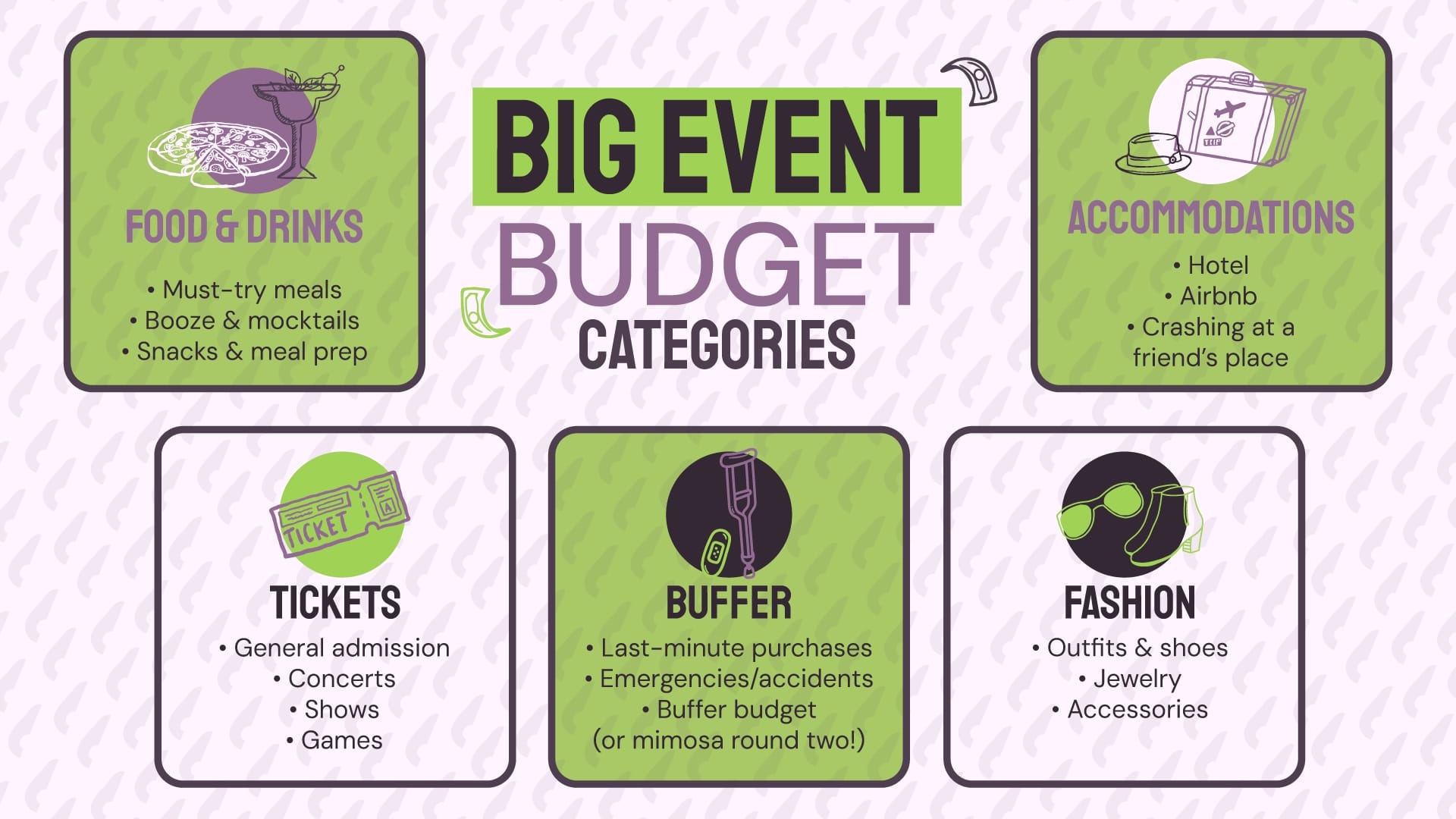Your one-stop guide to creating the best event budget
Planning and building a budget for events has the potential to save you hundreds, all while still having fun.

Attending events can get expensive fast. One moment you’re dancing at a concert, the next you’re waking up to a $500 charge on your credit card. If that sounds like you, you’re not alone. One survey found that 37% of Gen Zs and 39% of millennials spent between $500 and over $5,000 just on live entertainment tickets in 2024.
There’s nothing wrong with spending on events. But between rising costs and a chaotic job market, times are tough for young people who want to have fun without breaking the bank. The good news? With a bit of planning and budgeting finesse, you can. And we’re here to show you how. Before you know it, you’ll be attending events with newfound financial confidence.
Decide how much you want to spend
Deciding on a spending goal for an event is the first step toward creating a budget that is easy to stick to. It will also help you figure out how much you need to save before an event.
Let’s say your goal is to spend no more than $500 on a weekend getaway that is five weeks away. That means you need to save $100 per week to build your budget ($500/5 weeks).
Limiting how much you spend on unnecessary expenses like takeout, movies, and bars will make saving $100 per week easier. The earlier you start, the less you have to save per week!
Setting a goal and building a budget might sound tough now, but it will be worth it when you are sipping guilt-free margaritas by the pool. You earned those drinks!
Save money by planning for events early
Next, you want to check off as many expenses as possible before an event rather than leaving them to the last-minute and having to spend a fortune all at once! By taking care of expenses ahead of time, you can spread costs across multiple paychecks and potentially save hundreds of dollars while you are at it!
That’s because the price for things like hotels, tickets, and plane tickets will increase the closer you get to an event because there is more demand chasing limited supply. To give an example, the average daily room rate for a hotel in Calgary was $163 a night in April 2024. During the Stampede that year, that number jumped to $261, with some rooms charging over $500.
Another example is flights. On Expedia, round-trip flights from Ottawa to Calgary are upwards of $1,000 during the Stampede, with the two most expensive dates being the last two days of the event. You could get those same tickets for less than $400 if you booked in advance. For maximum savings, Expedia recommends booking at least three to six months in advance during peak seasons.
That’s $600 you can put toward your savings, investments, or maybe a few extra treats at your next event.
Tackling as many expenses as possible well before an event spreads the cost and can save you hundreds of dollars, ensuring you get the most out of your money and can focus on having fun!
Break your budget down into buckets

The next step toward building a bulletproof budget is to break your budget down into buckets. This will make it easier to keep track of your spending and stay within your spending goal.
- Pick your buckets: Your budget for the weekend getaway is $500, but where do you plan to spend that money? Your answer will determine your buckets. Common buckets are food, drinks, souvenirs, and extras.
- Assign a weight and limit: Next, weigh your buckets and assign a dollar limit. If you are a foodie who plans to sample the local cuisine, you might weigh your food bucket more heavily than the others and assign half of your budget to food-related expenses.
- Adjust accordingly: If you end up overspending on one bucket, don’t sweat it. Just reduce your spending in one or more buckets to compensate.
Breaking your budget down into buckets gives you the freedom to decide how you want to spend your hard-earned money while also making it easier to keep track of your spending. The less time you spend checking your bank account, the more time you can spend enjoying events!
Build a budget buffer
Don’t forget to put the “budge” in budget! When budgeting for an event, add a buffer that you can spend on unexpected purchases to maximize your savings, kind of like a mini emergency fund. Except, if you choose to spend it on an extra drink or a deep-fried Oreo, you can!
Your buffer should be 10-15% of your budget, so if your budget is $500, your buffer should be between $50 and $75. Is there a cool ride you want to check out? Use your buffer! Did you lose your concert wristband and need to buy another? Use your buffer!
By creating a buffer, you can enjoy some spontaneity without breaking your budget while also being prepared for unexpected expenses.
TL;DR
By following these four key steps, you’ll be able to have fun at events while also saving money for your future:
STEP 1: Set a clear spending goal ahead of time
STEP 2: Save money by checking off big expense in advance
STEP 3: break your budget down into buckets
STEP 4: build a budget buffer
You shouldn’t have to choose between having fun at events and being able to afford rent. By following these steps, you will be able to have your avocado toast and eat it too, whether it’s attending a wedding in Spain or the Calgary Stampede (see how we budgeted for the Calgary Stampede this year on our IG!).
